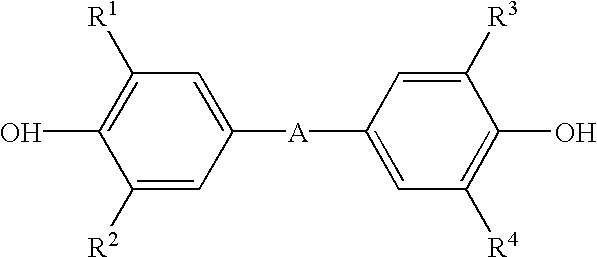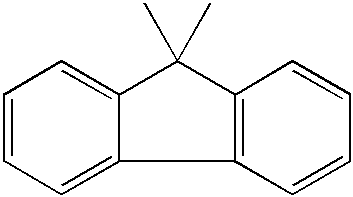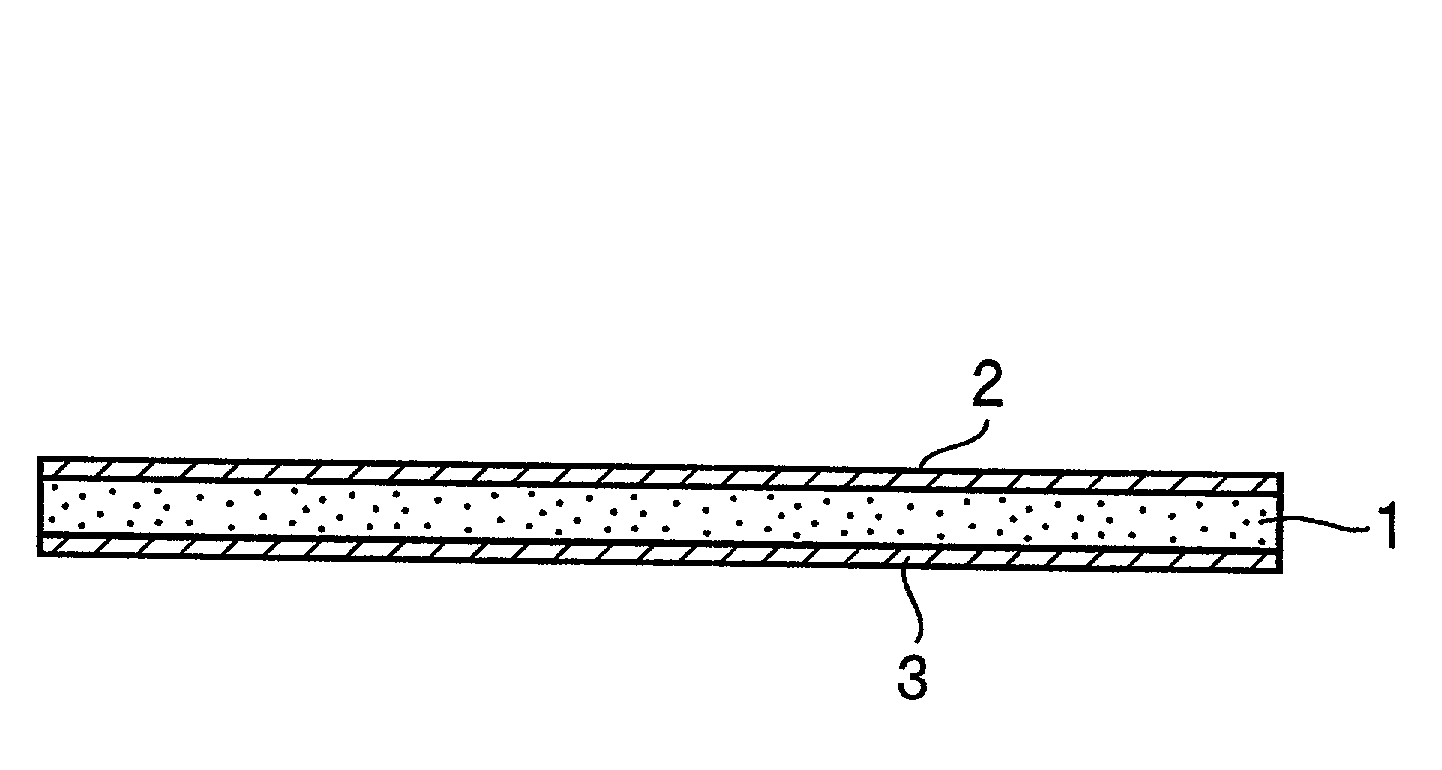Thermosetting composite dielectric film and method of manufacturing same
- Summary
- Abstract
- Description
- Claims
- Application Information
AI Technical Summary
Benefits of technology
Problems solved by technology
Method used
Image
Examples
example 2
[0056] A thermosetting composite dielectric composition was prepared by stirring, at a room temperature and an atomospheric pressure for 30 minutes using an Ishikawa type stirring crusher, a solution obtained by dissolving 22.60 g of epoxidized polybutadiene (commercial name "EPOLEAD PB3600" manufactured by DAICEL CHEMICAL INDUSTRIES, LTD., epoxy equivalent: 188-213, viscosity at 25.degree. C.: 100-200 Pa.s) as a thermosetting resin in 11.30 g of methyl ethyl ketone, 0.45 g of 2,4-diamino-6-(2'-methylimidazolyl-(1'))-ethyl-s-triazine as a curing catalyst and 215.40 g of barium titanate (particle diameter 1.16 .mu.m) as dielectric ceramics having a high dielectric constant.
[0057] Using the obtained thermosetting composite dielectric composition, a thermosetting composite dielectric film was prepared in the same manner as Example 1. The amount of the residual solvent in this thermosetting composite dielectric film was measured in the same manner as Example 1 and was found to be less t...
example 3
[0059] A thermosetting composite dielectric composition was prepared by stirring, at a room temperature and an atomospheric pressure for 30 minutes using an Ishikawa type stirring crusher, a solution obtained by dissolving 10.09 g of a dicyclopentadiene type epoxy resin (commercial name "EPICLON HP-7200" manufactured by DAINIPPON INK AND CHEMICALS, INCORPORATED, epoxy equivalent: 260) as a thermosetting resin and 26.92 g of a liquid alicyclic epoxy resin (commercial name "EPIKOTE YL6753" manufactured by Japan Epoxy Resins Co., Ltd., epoxy equivalent: 181, viscosity at 25.degree. C. 2.4 Pa-s) as a low-viscosity epoxy resin in 20.05 g of methyl ethyl ketone, 0.38 g of 2, 4-diamino-6-(2'-methylimidaz-olyl-(1'))-ethyl-s-triazine as a curing catalyst and 147.84 g of barium titanate (particle diameter: 1.16 .mu.m) as dielectric ceramics having a high dielectric constant.
[0060] Using the obtained thermosetting composite dielectric composition, a thermosetting composite dielectric film was ...
example 4
[0064] Using a chalcone group-containing bisphenol-epichlorohydrin type epoxy resin (weight average molecular weight: 14000, chalcone group content: 0.7 mole / kg, epoxy content: 0.85 mole / kg, epoxy equivalent: 1176) as a thermosetting resin, a mixed solvent varnish (solid content 49.12 wt. %, A / B / C=29 / 21 / 50 weight ratio) containing the above resin, diethyleneglycol monomethyl ether (A), dimethylacetamide (B) and methyl ethyl ketone (C) was prepared. A thermosetting composite dielectric composition was prepared by stirring, at a room temperature and an atomospheric pressure for 30 minutes using an Ishikawa type stirring crusher, 12.59 g of the above mixed solvent varnish, 5.00 g of a liquid alicyclic epoxy resin (commercial name "EPIKOTE YL6753" manufactured by Japan Epoxy Resins Co., Ltd., epoxy equivalent: 181, viscosity at 25.degree. C.: 2.4 Pa.s) as a low-viscosity epoxy resin, 0.20 g of 2,4-diamino-6-(2'-methylimidazolyl-(1'))-ethyl-s-triazine as a curing catalyst, 106.69 g of ba...
PUM
| Property | Measurement | Unit |
|---|---|---|
| Angle | aaaaa | aaaaa |
| Viscosity | aaaaa | aaaaa |
| Percent by volume | aaaaa | aaaaa |
Abstract
Description
Claims
Application Information
 Login to View More
Login to View More - R&D
- Intellectual Property
- Life Sciences
- Materials
- Tech Scout
- Unparalleled Data Quality
- Higher Quality Content
- 60% Fewer Hallucinations
Browse by: Latest US Patents, China's latest patents, Technical Efficacy Thesaurus, Application Domain, Technology Topic, Popular Technical Reports.
© 2025 PatSnap. All rights reserved.Legal|Privacy policy|Modern Slavery Act Transparency Statement|Sitemap|About US| Contact US: help@patsnap.com



